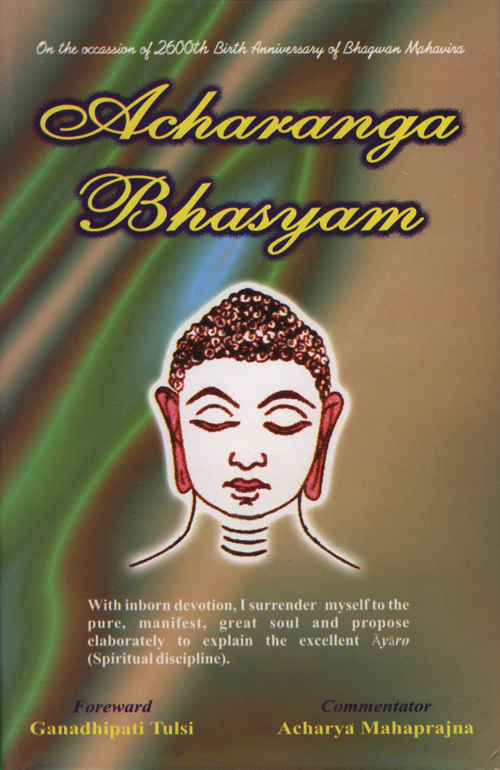According to the Niryukti, there are 18000 padas (verses) in the Ācārāṅga. But this number includes padas in both śruta-skandhas. According to the Samavāyāṅga and the Nandῑ, however, this number corresponds to only the first part of the Ācārāṅga, as mentioned by the Niryuktikāra.[1]
Abhayadeva Suri has also mentioned the same number. But today we do not find 18000 padas. This number of padas is only of the nine Brahmacaryādhyayanas of Ācāra.[2] According to the tradition, it is believed that this number was there in the period, when the Ācārāṅga was composed, but with the passage of time, some portion of the text was lost.
According to the Digambara tradition, Nakṣatrācarya, Jayapāla, Pāṅḍusvāmῑ, Dhruvasena and Kansācārya—these five Ācāryas were considered well-versed with eleven Aṅgas and a part of the Pūrva. They were followed by Samudra, Yaśobhadra and Lohārya who were well-versed with the Ācārāṅga and a part of other Aṅgas and Pūrvas.[3]
But by the year 683 Post-Vῑra-nirvāṇa, this tradition of Ācārāṅgadharas comes to an end. Even then it has been accepted that the later Ācāryas subscribed to all the Aṅgas and a part of Pūrvas.[4] Like the belief of the Digambara tradition, the Śvetāmbaras also acknowledge that the extinction of the text of the Ācārāṅga took place with the death of Viṣṇu Muni.[5] But it took place in the year 1300 (Post-Vῑra-nirvāṇa) i.e. 773 A.D. according to the 'Titthogālῑ’.[6]
On the basis of above discussions, we can conclude that the text of the Ācārāṅga has, no doubt, been abridged to a certain extent, but not all together lost. The reason for this is that when the Ācārāṅgadharas were no more and the monks that became prey to forgetfulness, in the absence of the tradition of recitation, the text became extinct. But according to Acharya Śilaṅkasūri (8th century), the text of ācārāṅga was available in his time and as such it was not totally lost. The Śvetāmbara Ācāryas believed that the Mahaparijñā - the seventh chapter of the Ācārāṅga, has been lost. This happened between the 1st century and the 8th century A.D.
Vajrasvāmi has protruded from that chapter the science of 'flying' [7] and thus we know that this study was available in his times. But Silanka Suri (8th century) has mentioned that Mahaparijñā has been lost.[8] However, the Niryuktikāra has mentioned [9] the subject matter of Mahaparijñā chapter and has composed Niryukti on it.[10] This proves that this chapter was not extinct by his time. But the Cūrṇikāra does not mention about extinction of Mahaparijñā. He states that it has been excluded from the studies.[11]
He does not give any clue as to why it was excluded from the studies. According to one belief, 'Mahaparijñā' contained many mantras and mystical practices. It was thought at that time that such studies would not yield good results and hence Mahaparijñā was excluded from the studies by the Ācāryas of that period. But this view is not acceptable to the Niryuktikāra. According to him, the seven chapters of Āyāracūlā (second part of Ācārāṅga) were protruded from Mahaparijñā.[12] Considering this, one comes to the conclusion that the subject matter of Mahaparijñā was the same as we find in the chapters of Āyāracūlā today.
Samavāyāṃga Vṛtti, patra 101: yad dau śrutaskandhāvityādi tadācārasya pramāṇaṃ bhaṇitaṃ, yat punaraṣṭadaśa padasahasrāṇi tannavabrahmacaryādhyayanātmakasya prathamaśrutaskandhasya pramāṇam.
Ibid, part I, p.67: tado savvesimaṃgaṃ puvvāṇa megadeso āiriya-paraṃparāe āga cchamāṇo dharcseṇāiriyaṃ saṃpatto.
titthogālῑ etthaṃ vattavvā hoi āṇupuvvῑe.
je tassa u aṃgassa, vuddhedo jahiṃ viṇidiṭṭho..
Ācārāṅga Vṛtti, Patra 235: adhunā saptamādhyayanasya mahāparijñākhyasyāvasaraḥ, tacca vyavacchinnamitikṛtva'tilaṃghyāṣṭamasya sambandho vācyaḥ.
 Acharya Mahaprajna
Acharya Mahaprajna

